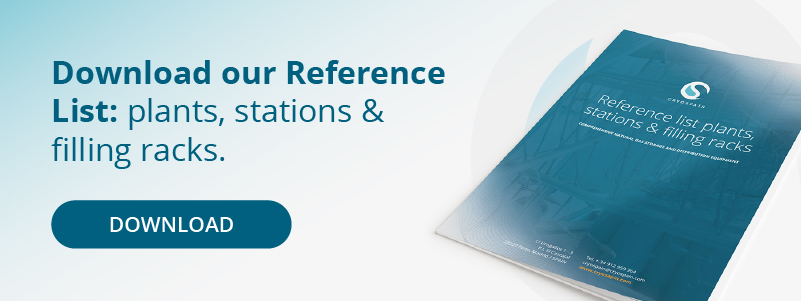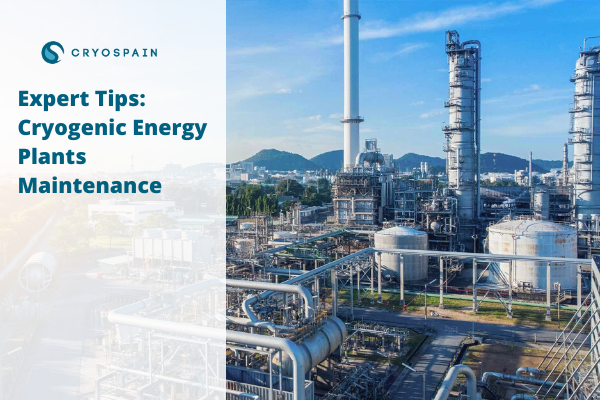The convoluted energy situation that the world is facing today has led interested parties to search for efficient alternatives. The rise of cryogenic energy plants responds to this need, providing a solid possibility for energy generation that solves many of today’s issues.
We look at how cryogenic power generation works and the adequate cryogenic plant maintenance to ensure safety, resource optimization and long-term continuity.
What are cryogenic energy plants
Cryogenic energy plants use liquid air storage technologies to store energy. The cryogenic power generation system follows a two-way process. First, air is compressed and chilled until it reaches a liquid state. The resulting substance, which fills a significantly less space, allows for the storage of big quantities of energy.
Secondly, energy is retrieved by following an inverse process: liquid air is heated until it reaches a gaseous state. It’s then decompressed and released, sent towards a turbine, whose movement generates electricity.
There are other cryogenic power possibilities being investigated at this moment. Such is the case of green hydrogen energy plants. These installations first need to gather hydrogen. They do so by using waste electric energy or other alternative resources (including solar fields, aerogenerator fields or hydroelectric centrals).
Applied to water electrolysis processes, it decomposes water into oxygen and hydrogen, and the latter is stored in cryogenic tanks in its liquefied state. The result allows for the use of fuel batteries that guarantee the production of electricity. Additionally, natural gas has also been used to obtain hydrogen, a process requiring high temperatures to make water vapor in natural gas react with methane.
Types of cryogenic energy plants
- Liquid air energy storage: these cryogenic energy plants use liquefied air or liquid nitrogen as a storage technology.
- LNG Cryogenic Power Generation: this cryogenic power generation method employs Liquefied Natural Gas to generate electric power as this substance is vaporized and expanded.
Related content: How is cryogenic energy storage used in nuclear power plants?
Cryogenic plant maintenance: the keys
The key tests to undertake
- Cryogenic pumps testing and maintenance: centrifugal and piston cryogenic pumps must be observed regularly by professionals to determine if repair operations are needed
- Cryogenic pumps skid’s correct operations
- Helium leak detection tests in cryogenic high-vacuum piping: this represents the most reliable and safe testing method to help companies detect potential leaks and monitor the equipment’s vacuum state
- Dewar and ranger maintenance processes: this applies for cryogenic energy plants that include cryogenic bottle filling stations. Several operations are comprised in this category, including analyzing vacuum levels, specific helium leak detection tests, seal testing, repairing of instruments (wheels, pressure regulators, pressure gauges…), re-stamping and sterilization for dewars, all while complying with relevant standards and rules.
- Tanker trucks: again, this operation only applies when tanker trucks are part of cryogenic energy plants. Common maintenance operations in these include helium leak tests, cleaning, degasification, depressurizing, repairing or modification of their parts, including bombs, engines and tanks. It’s advisable for the maintenance operations in cryogenic tanker trucks to take a preventive approach.
Legislation and regulations
On the one hand, the different national legislation bodies will typically include laws relating to cryogenic plant maintenance. For instance, in Spain it’s the Real Decreto 809/2021 for pressurized equipment.
These norms commonly include requirements for companies regarding the following topics: a classification of pressure equipment, approved certifications for personnel, security requirements for valves, extinguishers, vacuum testing, inspection requirements and pressure testing.
Regarding tanker trucks, these must comply with the European regulation for the Transport of Dangerous Goods
Alongside these legal requirements, there are a number of international standards regulating correct cryogenic plant maintenance. This includes:
- ISO 9001:2008
- ISO 9001
- ISO 15848-1:2006(E).
- ASTM E498
- ASTM E499
Keep reading: Cryogenic plants: how we design and create tailor-made units for our clients
Cryospain: experts in all types of cryogenic maintenance
At Cryospain, we provide extensive maintenance services for cryogenic equipment.
Based on our capacities to provide a 360º service from a preventive maintenance perspective, we generate professional periodic inspections and repair operations for cryogenic equipment.
Regarding cryogenic plant maintenance in particular, we’re able to provide helium tests, as well as the required maintenance operations for cryogenic pumps, skids, bottle filling stations and tanks, having been in charge of more than 2,000 repairing cases.
Want to learn more about cryogenic plant maintenance and how to ensure cryogenic energy plants achieve their full potential? Get in touch with us and learn more about our preventive maintenance and repairing services.











 Contacte-nos
Contacte-nos